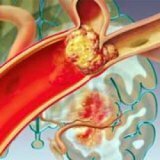Aneurysm of the aorta: symptoms, treatment, prevention
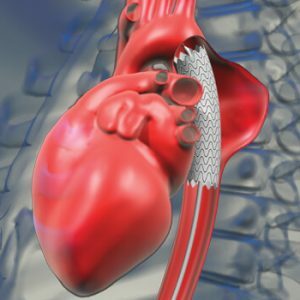 The aorta is the largest, most powerful blood vessel in the human body.Powerful, therefore, it seemed, it "does not take anything".However, an aortic aneurysm is a scourge of modern cardiovascular surgery.In normal condition in adult women and men, the diameter of the lumen of the ascending part of the aorta is about 3 cm, the descending segment is 2.5 cm, the abdominal segment of this large vessel is even smaller - 2 cm. An aneurysm is diagnosed only if the diameter of the affected aorta increasesIn 2 and more times in comparison with the norm.
The aorta is the largest, most powerful blood vessel in the human body.Powerful, therefore, it seemed, it "does not take anything".However, an aortic aneurysm is a scourge of modern cardiovascular surgery.In normal condition in adult women and men, the diameter of the lumen of the ascending part of the aorta is about 3 cm, the descending segment is 2.5 cm, the abdominal segment of this large vessel is even smaller - 2 cm. An aneurysm is diagnosed only if the diameter of the affected aorta increasesIn 2 and more times in comparison with the norm.
Determination of aortic aneurysm
Aortic aneurysm is a local( local) protrusion in the form of a sac in a specific section of this large vessel.It is provoked by the weakness of the aortic wall, which( weakness) can be affected by all or several layers of the wall.
This extension is irreversible.Here's a good example.If you inflate a normal baby ball and then release air from it - it will take the form of a flat "petal", in the form of which it was released at the factory.
If the aortic wall "inflates", it will never return to its original position. 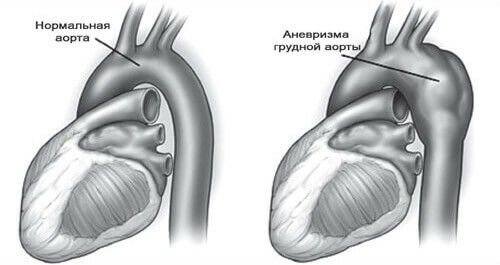
An aneurysm can form in any of the aortic segments, but most often it affects the abdominal part of the vessel - in a third of the diseased( or rather, 37%).
The thoracic aorta has "distinguished itself" not only by the fact that an aneurysm is most often affected - its aneurysmal enlargement is often combined with various aortic malformations.Common:
- aortic insufficiency;
- coarctation( constriction) of the aortic lumen.
According to the segmental classification, the following types of this disease were identified:
- sinus aneurysm of Valsalva - the aorta widened the area in the root of the aorta, at the point of its departure from the cardiac chambersHalf-moon valves);The disease "confuses the cards" in the diagnosis of vascular and cardiac diseases, so it will be discussed in more detail below;
- aneurysmal protrusion of the ascending segment of the aorta;
- an aneurysm of the arch( the place where the aorta steeply bends and rushes down towards the abdominal cavity);
- aneurysm expansion of the descending fragment;
- abdominal aneurysm;
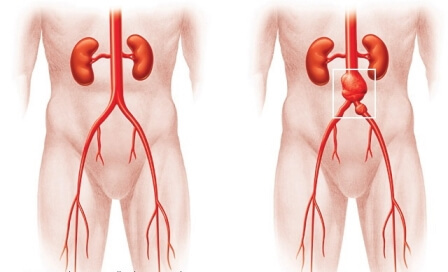
- combined aneurysm( in the pathological process, a portion of the vessel that passes between the thorax and abdominal cavity is involved).
The morphological structure of the aortic aneurysm distinguishes:
- true - protrusion affects all layers of the wall, they are approximately the same extent thinned, as a result - a "bag" with walls and cavity is formed;Most often appear due to pronounced atherosclerosis or a syphilitic process that affected the aortic wall;
- false( pseudoaneurysms) - in this case, full( with walls and lumen), bulging out "bag" as such there is no;The wall of such an aneurysm is "constructed" from a connective tissue massif formed on the site of blood accumulation.But the aortic wall in the pathological process is not involved.Such aneurysms appear in most cases after traumas or operations( which in their own way are also traumatized).
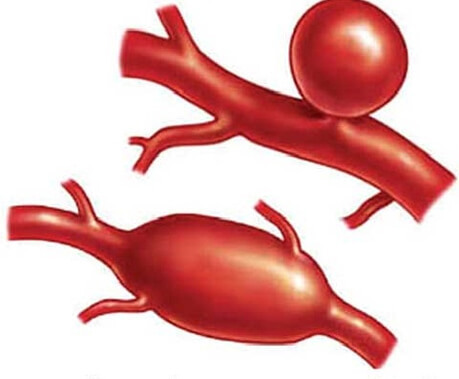 The aneurysm form can be:
The aneurysm form can be:
- saccate - "one-sided" bulging of the aortic wall( up to the fourth part of the circumference, the rest of the wall remains normal);
- spindle-shaped - visually in fact similar to an ancient spindle, because the wall of the vessel bulges evenly over the entire circumference.
According to the clinical course of the aneurysm there are:
- uncomplicated;
- complicated when bulging the aortic wall by pushing to another pathological process, or even several;
- splits when the aorta wall is divided into layers at the site of the lesion, this happens due to the fact that the blood is literally seeping between the layers of the wall, moving gravitationally further, thus "pushing" the wall layers.
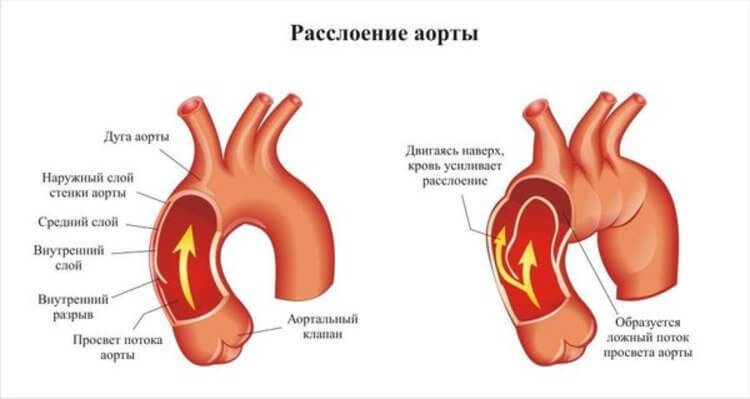
:
- breaks( breakthrough in a weakened place) of the thin wall of an aneurysmal sac; is the most common complication of aortic aneurysm;
- as a consequence of aneurysm rupture - profuse, life-threatening bleeding and clot formation( hematoma);
- thrombosis of an aneurysmal sac - the formation in it of one or more( sometimes merged into one) clots due to accumulating blood;
- of thromboembolism of arteries in the periphery due to the separation of blood clots that were "born" in an aneurysmal protrusion;
- infection of the cavity of the aneurysm, as a result - abscessing( gnoyobrazovanie).
Causes of the disease, provoking factors
All aortic aneurysms are divided according to their origin into:
- congenital;
- purchased.
Congenital diseases result from the fact that "something went wrong" in the process of embryonic laying of the aortic elements - this leads to:
- Marfan syndrome is a congenital deficit in the development of connective tissue;
- Elastin deficiency, transmitted in the family by inheritance;
- Ehlers-Danlos syndrome - defective development of collagen elements
and some others.
Acquired aneurysms are not formed on a flat surface, but mainly after aortitis - inflammatory and non-inflammatory pathologies of the aortic wall.
Inflammatory lesions, due to which its wall is thinned and an aneurysm becomes bulging, occur in most clinical cases:
- after syphilis;
- because of postoperative infections of the thoracic cavity;
- because of fungal aortic lesions.
Non-inflammatory lesions and aortic conditions following which an aneurysm may occur is:
- is a long-standing, "stale" atherosclerosis with a large number of atherosclerotic plaques clotting the internal "lining" of the aorta over a long stretch and obstructing the normal blood flow of the ; because of this the blood flow changes direction, the blood begins to press in the compromised aortic site, under pressure and protrusion of the wall of this large vessel is formed;
- unsuitable suture material used for aortic surgery;
- defective aortic aorta.
The factors that themselves do not cause the formation of an aortic aneurysm but also contribute to its occurrence are identified:
-
 is an elderly age when the vascular wall logically loses its elasticity, while the resistance to the blood flowing current decreases;
is an elderly age when the vascular wall logically loses its elasticity, while the resistance to the blood flowing current decreases; - male gender;
- hobby for alcohol and smoking cigars, cigarettes, tobacco pipes ;
- hereditary predisposition;
- enhanced action of proteolytic enzymes, which "eat" the elastic elements of the aortic wall.
Pathogenesis( development) of the disease
The mechanics of the formation of the aortic aneurysm is quite simple.At some point of its wall elasticity decreases, all layers become less sturdy and more pliable. The aorta is a powerful vessel, and the blood flow in it is more powerful than other peripheral vessels of the human body.This means that the blood presses on the weak point, in this location the wall at some point does not stand the pressure, thins, "creeps" and swells( according to the principle of a child's ball, whose walls are thinned because of the pressure injected into the air) .There is a protrusion, called an aneurysm.
Then the weak point becomes weaker and weaker, because the blood rushes into the aneurysm and continues to press against its wall, this leads to its even more thinning. Moreover, getting into the aneurysm, the bloodstream becomes vortex, which additionally increases the duration and force of blood pressure on the affected segment of the wall.
Empirically, if the blood pressure stopped, the wall changed at the microlevel will not restore its shape anyway( in contrast to the principle of a blown ball, the walls of which become thicker from the thin, if air is released from the inside).Symptoms of aortic aneurysm
The aneurysm of the aorta manifests itself in different ways - mainly it depends on the size of the aneurysmal sac and its location ( below - a clear clinical picture with the sinus aneurysm of Valsalva as an example). In a number of cases, there are no symptoms at all( in particular, before aneurysm rupture, but this will be another diagnosis), which makes it difficult to diagnose in advance.
The most frequent complaints from patients with an aneurysm of the ascending aortic fragment:
-
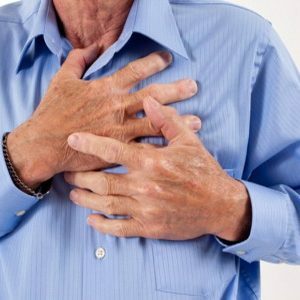 chest pain( in the heart or behind the breastbone) - due to the fact that an aneurysmal protrusion pressure on closely located organs and tissues,And also because of the pressure of the blood flow on the thin and feebly wall;
chest pain( in the heart or behind the breastbone) - due to the fact that an aneurysmal protrusion pressure on closely located organs and tissues,And also because of the pressure of the blood flow on the thin and feebly wall; - shortness of breath, aggravated with time;
- sensation of heartbeat ( "Like something pounding in the chest" - a comment of patients);
- dizziness;
- with large sizes of aneurysm disturb the attacks of headaches, puffiness of the soft tissues of the face and upper body - due to the development of the so-called syndrome of the superior vena cava( because an aneurysm presses on the upper vena cava).
For an aortic arch aneurysm is characterized by:
-
 difficulty swallowing( due to pressure on the esophagus);
difficulty swallowing( due to pressure on the esophagus); - hoarseness, sometimes coughing - in case an aneurysm presses on the recurrent nerve, which "answers" for the voice;
- Suddenly increased salivation and a rare pulse - if pressure extends to the vagus nerve, controlling salivation and heart rate;
- strained breathing, and later dyspnoea in the case of squeezing the trachea and bronchi with a huge aneurysm;
- unilateral pneumonia - if an aneurysm, pressing on the root of the lung, interferes with its normal ventilation, then, as a consequence, there is stagnation in the lungs, with the attachment of infection flowing into the pneumonia.
With aneurysm of the descending part of the aorta,
-
 appears in the left arm( sometimes to the fingers themselves) and the scapula;
appears in the left arm( sometimes to the fingers themselves) and the scapula; - at pressure on the intercostal arteries, the lack of oxygen supply of the spinal cord may develop, because of this, pareses and paralysis are imminent;
- in case of permanent long pressure of a large aneurysm on the vertebrae, even their displacement is possible, in more light cases, due to pressure on the intercostal nerves and arteries - pain, as with radiculitis or neuralgia.
The most common complaints for an aneurysm of the abdominal segment of the aorta:
- sensation of stomach overflow and heaviness in the epigastrium( upper abdomen), which the patient initially tries to explain by overeating or stomach pathology;
- belching;
- in some cases - a vomiting of a reflex character( appears as a reaction to the pressure of the aortic aneurysm on closely located organs and tissues).
In palpation, a tense, pulsatile, tumor-like formation is palpated.Sometimes patients can independently identify this pulsation.
Complications of the disease
An aneurysm is not as dangerous as complications in its progression:
- rupture of the aneurysm wall in the thinnest place and, as a result, massive internal bleeding and sudden onset of heart failure;
- is a syndrome of ERW( upper vena cava), described above;
-
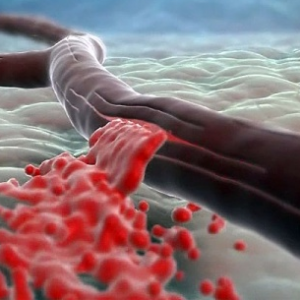 hemopericardium( the presence of blood in the pericardial cavity) and the cardiac tamponade that followed it - the pressure on the heart of the pericardial blood poured out in the pericardial cavity, almost instantly disrupting the heart and normal hemodynamics( blood flow);
hemopericardium( the presence of blood in the pericardial cavity) and the cardiac tamponade that followed it - the pressure on the heart of the pericardial blood poured out in the pericardial cavity, almost instantly disrupting the heart and normal hemodynamics( blood flow); - various bleedings due to rupture of the thinned aneurysm wall: hemothorax( outflow of blood into the pleural cavity), pulmonary, intraperitoneal, gastrointestinal bleeding, or a combination thereof;
- , because of the rupture of a blood clot that has "settled" in the cavity of the aneurysmal sac, thromboembolism( blockage) of any part of the vascular system can occur, mainly arteries of the extremities, but cerebral arteries can be blocked, which manifests itself by stroke or renal arteries, which results inAcute renal failure.
Diagnosis of aortic aneurysm and its complications
Aortic aneurysm in the period before the break has rather poor clinical manifestations:
- noises that are audible during auscultation;The doctor listens not only to the thorax, but also to the abdominal cavity;
- is a tumor-like pulsatile formation that is found with a deep but cautious palpation( sometimes actually regarded as a tumor, as it is quite dense to the touch);
- incomprehensible discomfort at the site of an aneurysmal protrusion.
Therefore, to clarify the pathology, until it is "born of" dangerous complications, apply instrumental diagnostic methods:
-
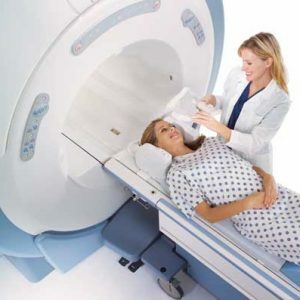 X-ray and chest and abdominal chest X-ray - they visualize tumor formation( its pulsation can be seen with fluoroscopy);
X-ray and chest and abdominal chest X-ray - they visualize tumor formation( its pulsation can be seen with fluoroscopy); - echocardiography - with suspected aneurysm of the ascending aorta;
- ultrasound dopplerography( UZDG) - with signs of aneurysm of other aortic sites;CTD and MRI.
Treatment and operation for aortic aneurysm
If an aneurysm is diagnosed but its progression is not observed, doctors take on conservative tactics :
- further close observation of the vascular surgeon and cardiologist - monitoring of general condition, blood pressure, Pulse, repeated performance of electrocardiography and other more informative methods to follow the possible progression of the aneurysm and in time to notice the prerequisites forAneurysm complications;
- antihypertensive therapy - in order to reduce blood pressure on the thin wall of an aneurysm;
- anticoagulant treatment - to prevent the formation of blood clots and possible subsequent thromboembolism of medium and small vessels;
- decrease in the amount of cholesterol in the blood( with the help of both drug therapy and diet).
The surgical intervention is resorted to in such cases:
- large aneurysms( at least 4 cm in diameter) or with a rapid increase in size( half a centimeter in six months);
- complications that threaten the patient's life - aneurysm rupture and others;
- complications, although they are not critical in terms of death, but dramatically decrease the patient's quality of life - for example, pressing on nearby organs and tissues, which causes pain, dyspnoea, vomiting, belching and the like.
Surgical treatment consists in excision of the "loosened" section of the aortic wall, which formed an aneurysm, and suturing the formed hole .For large defects after resection of a large aneurysm, aortic aortic prosthesis should be performed - otherwise suturing the opening may lead to stretching of the tissues and insufficiency of the sutures( thread eruption) or, at best, narrowing of the operated aortic site, which will negatively affect the blood flow in this place.
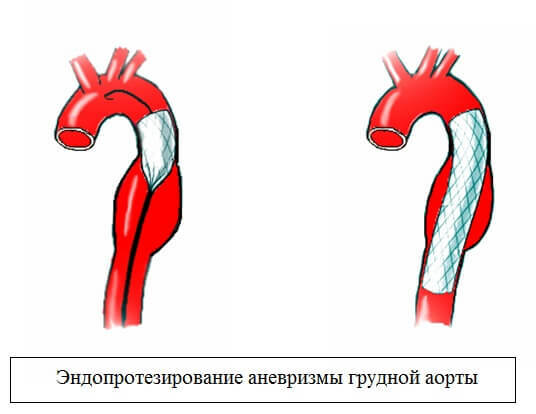
Prognosis for aortic aneurysm
Aneurysm of the aorta is a nosology that must be constantly monitored by doctors.The reason is possible complications, which in most cases threaten human life.Over time, the aneurysm progresses morphologically( the altered wall becomes thinner and thinner, the protrusion increases). Life and health of a patient can be saved only through careful monitoring of the course of the disease and, if necessary, immediate intervention.
Preventative measures
Prevention, which can prevent the occurrence of aortic aneurysm in healthy people, nonspecific( that is, effective not only in the case of this pathology) and includes:
- complete quitting;
- reduction of alcohol standards to the level of "only for the holidays", or better complete failure;
- physical education and sports;

- elimination of factors causing an increase in blood pressure( stress, kidney disease);
- cure and prevention of pathology, which promotes the formation of an aortic aneurysm( atherosclerosis);
- immediate alertness with a sudden, at first glance inexplicable occurrence of cardiac, gastrointestinal and respiratory system disruptions and immediate examination by specialized specialists to exclude aortic aneurysm;
- regular quality, and not for "tick", prophylaxis in a vascular surgeon and cardiologist.
If aortic aneurysm is already available, preventive measures are indicated to prevent complications of the disease:
- competently selected anticoagulant therapy to prevent the formation of thrombi in the lumen of the aneurysm;
- significant reduction in the financial load - otherwise they can cause an overstrain of the thin wall of the aneurysm, which will turn into a rupture;Sometimes a complete refusal of physical exertion is necessary until the doctor clarifies the diagnosis and assesses the risk;
- antihypertensive treatment - thanks to it, it is possible to avoid the buildup of blood pressure pressure on the thin wall of an aneurysm, which can burst at any time;
- thorough psychological control - in some patients, even minor stressful situations pushed the aortic aneurysm into rupture.
Since this is not a common type of aneurysm, it is forgotten about the possibility of its existence, and this confuses the physician for diagnosis( for example, the impossibility of explaining arrhythmias that arise "on the level").
An aneurysm of sinus Valsalva can be congenital( more often) and acquired( less often).This is the protrusion of aortic sinuses in the form of a sac or a finger. It is interesting that about 70-80% of patients with an aneurysm of sinus Valsalva are representatives of the male sex.
Most often an aneurysmal bulging is found in the right coronary sinus.But the clinic describes the cases of the defeat of all three coronary sinuses.
Often, an aneurysm is placed in the intrauterine period, when there is insufficient development of the reinforcing fibrous ring, but it does not appear at birth at all( and for instrumental diagnosis it makes no sense to examine all babies entirely). This is a scourge of a rather young age - the rupture of such an aneurysm is found mainly in the age range from 20 to 40 years. An aneurysm is often found in young people already post-factum - in the event of a rupture.
Acquired Valsalva aneurysm is most often observed in adulthood and occurs due to other serious diseases.These are:
- syphilitic lesion;
- tuberculosis;
- infective endocarditis( infectious inflammation of the inner shell of the heart).
Until the rupture of the aneurysm, the clinic is either absent or very poor, because there are no changes in hemodynamics( blood flow) as such.In some cases, an aneurysmal sac pressure on cardiac structures with conductive pathways, which can cause arrhythmias.Therefore, if there are interruptions in the rhythm of the heart, the sinus aneurysm of Valsalva should be excluded.
Clinical signs are manifested when a thin wall of aneurysmic protrusion is ruptured:
- sharp, sometimes unbearable pain behind the sternum;
- the patient is getting heavier and heavier breathing;
- arterial pressure is reduced, the pulse is accelerating;
- signs of heart failure and bilateral pulmonary edema( cyanosis, increased dyspnoea).
Detection of an aneurysm of the sinus of the Valsalva is not an easy task: an aneurysm does not appear on the ECG, ECG changes are noted only when it breaks( ECG shows an overload of the heart because of the discharge of excess blood from the bursting bag).In the period before aneurysm rupture,
- is an informative esophagogastric echocardiography;
- MRI of the heart;
- Doppler ECG;
- aortography, with which you can see the contours of an aneurysmal sac.
Treatment is exclusively surgical - an aneurysmal protrusion is carved, in its place is patched . No methods of traditional medicine, just "not to cut", will not provide even a slight improvement in the patient's condition. The prognosis is complicated by the fact that it is difficult to diagnose an aneurysm of the sinus of Valsalva at the early stages of its existence.
Kovtonyuk Oksana Vladimirovna, medical reviewer, surgeon, consulting physician

